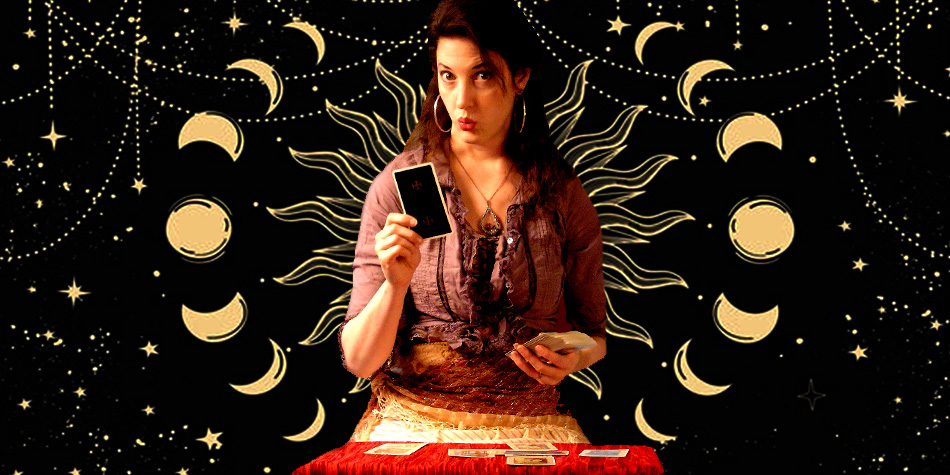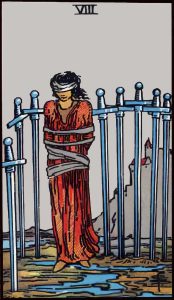
By Katrina Rasbold
The Tarot deck designed by Pamela Colman Smith under the guidance of Arthur Edward Waite is one of the most iconic and enduring images in esoteric symbolism. Each card is rich with layered meanings, psychological insight, and archetypal resonance. Among them, the Eight of Swords stands out as a visually striking and emotionally charged card. It is a card that immediately evokes feelings of entrapment and helplessness — yet, like all cards in Tarot, it holds a mirror to deeper truths, inviting us to look beyond surface-level suffering.
Let’s take a closer look at this powerful image, its symbolism, and the multiple ways it can be interpreted.
The Imagery: What We See
 The Eight of Swords, as illustrated by Pamela Colman Smith, depicts a woman bound and blindfolded, standing in a muddy or watery patch of ground. Around her stand eight upright swords, forming a kind of loose fence. Behind her looms a distant, gray fortress or city, isolated atop a rocky cliff under a brooding sky.
The Eight of Swords, as illustrated by Pamela Colman Smith, depicts a woman bound and blindfolded, standing in a muddy or watery patch of ground. Around her stand eight upright swords, forming a kind of loose fence. Behind her looms a distant, gray fortress or city, isolated atop a rocky cliff under a brooding sky.
At first glance, the figure appears trapped, vulnerable, and abandoned. Yet the image invites closer inspection, and when we look more carefully, we see that her bonds are loose, the blindfold could be removed, and the swords do not completely enclose her. There’s room to walk free — if only she could see.
Symbolism in the Card
1. The Blindfold
The blindfold symbolizes a lack of clarity, self-deception, or an unwillingness to confront reality. It’s a classic image of mental blindness, representing situations where the answers or escape routes are available, but the individual cannot see them — often because they are avoiding difficult truths.
2. The Bonds
Her loose bindings reinforce the idea that the restriction is not entirely imposed from the outside. Instead, it hints at self-imposed limitations. These are the narratives we tell ourselves — “I can’t,” “I’m stuck,” “There’s no way out” — that imprison us more effectively than external chains ever could.
3. The Swords
Swords in Tarot represent the intellect, thoughts, and often conflict. Here, they form a partial barrier. They symbolize the mental constructs — worries, fears, analysis paralysis — that trap the woman. The fact that they don’t fully surround her indicates that these constraints are perceived, not actual.
4. The Water at Her Feet
Water often represents intuition, emotion, and the unconscious. Its presence here, despite the intellectual symbolism of swords, suggests that emotional insight is close — it literally touches her — but remains unrecognized. She’s disconnected from her own feelings and inner wisdom.
5. The Gray Sky and Distant Castle
The overcast sky conveys gloom, confusion, and a lack of clarity. The castle or structure in the background could represent safety, a higher perspective, or detachment — but it is distant, seemingly unreachable in her current state. Yet symbolically, it is still within view, hinting that clarity and security are not forever lost.
Interpretation: Upright Meaning
When upright, the Eight of Swords is often read as:
- Feeling trapped, restricted, or powerless
- Victim mentality or paralysis by analysis
- Mental prisons and limiting beliefs
- A call to face fears and recognize self-imposed constraints
It frequently appears in readings where the querent feels overwhelmed by circumstance, unable to see a way out, or caught in cycles of worry or doubt. The key message? You are not as trapped as you believe. The card invites introspection, awareness, and the courage to act despite fear.
Interpretation: Reversed Meaning
When reversed, the Eight of Swords takes on a more hopeful or dynamic tone:
- Breaking free from limitations
- Gaining mental clarity
- Seeing through illusions
- A turning point in self-perception
Reversed, it can signal that the querent is starting to remove the blindfold, question their inner narratives, or recognize where they have more agency than they previously thought. It’s a card of empowerment in the midst of transformation.
Psychological and Archetypal Lens
Through a Jungian lens, the Eight of Swords represents the moment we are caught between our conscious reasoning and our unconscious fears. It is the ego’s confrontation with the inner saboteur — the voice of doubt, shame, and defeatism that keeps us small.
The card is an invitation to integrate awareness, to use the intellect not as a weapon of self-criticism, but as a tool for liberation. The path forward is not outside the self, but within — through perception, courage, and clarity.
A Mirror, Not a Sentence
Pamela Colman Smith’s artistry in the Eight of Swords lies in its ability to elicit empathy while simultaneously nudging the viewer toward insight. It’s a card that often comes at a critical moment — when you feel stuck, but are on the edge of a breakthrough.
Remember: the Eight of Swords doesn’t tell you that you’re doomed — it tells you that your liberation is already within your reach, if only you’re willing to see it.
Whether you’re a seasoned reader or a Tarot newcomer, the Eight of Swords serves as a powerful reminder: the mind can be both a prison and a key. Which one it is… depends on you.
Want to join the conversation about this blog post? Go to the Green Egg Forum and scroll for the forum post that relates to this article: https://www.facebook.com/groups/1069823176940972
 Katrina Rasbold is a professional Witch, published author, priestess, and editor of Green Egg Magazine. She and her husband, Eric, are the creators of the CUSP spiritual path and owners of Crossroads Occult. You can reach her through www.katrinarasbold.com.
Katrina Rasbold is a professional Witch, published author, priestess, and editor of Green Egg Magazine. She and her husband, Eric, are the creators of the CUSP spiritual path and owners of Crossroads Occult. You can reach her through www.katrinarasbold.com.